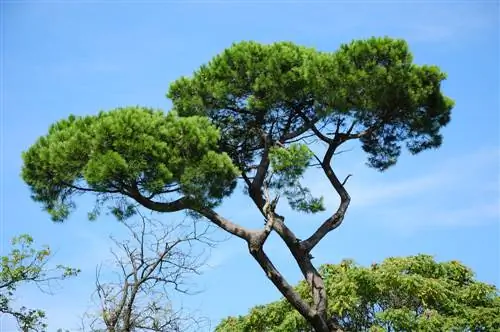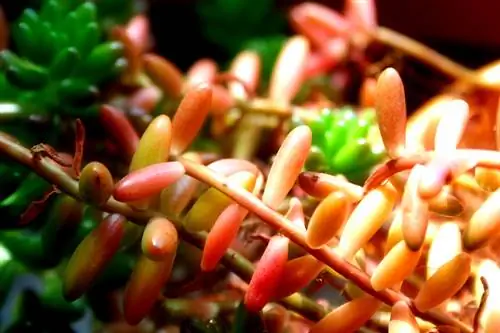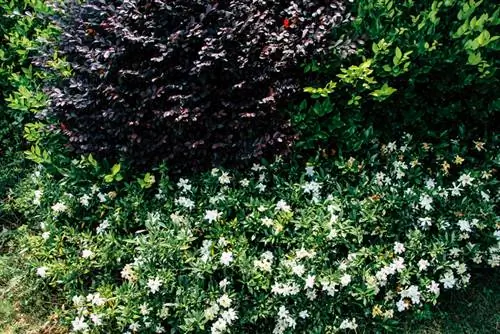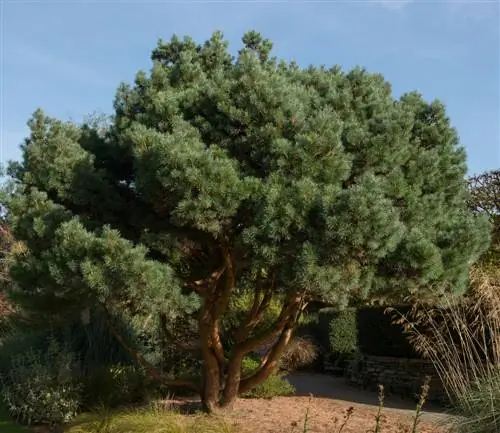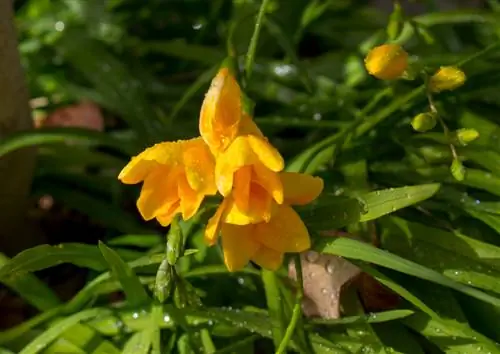- Author admin [email protected].
- Public 2023-12-16 16:46.
- Last modified 2025-01-23 11:22.
The Mediterranean pine tree in the garden and pots gives us the gift of enjoying the spicy scent of its needles under its shady canopy. The following answers to frequently asked questions show how easy it is to cultivate a Mediterranean pine tree.
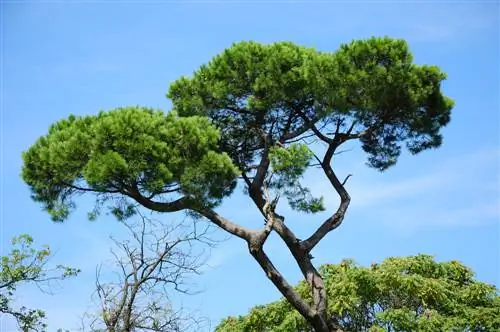
Can you plant a pine tree in Germany?
The pine tree, also known as the Mediterranean pine, can be cultivated outdoors in mild-winter wine-growing regions from the age of five. Protective measures are important in winter, such as a layer of leaves on the tree disc and a breathable hood over the crown.
Planting pine trees correctly
In the mild climate of a wine-growing region, you can dare the experiment of planting a pine tree outdoors. The suitable candidate should be at least 5 years old and completely he althy. Planting time is spring so that the Mediterranean pine has vital roots in the ground by the first winter. Choose a specimen in a container or in bales, as bare-root trees can only be planted in late autumn. In a sunny, wind-protected location, create a pit that is approximately twice as large in diameter as the root ball. How to proceed:
- Enrich the excavated soil with compost and horn shavings as well as some sand or lava granules
- Drive a support post into the planting pit before inserting the pine tree
- Plant the umbrella pine only deep enough that the root ball is flush with the surface of the soil
After you have attached the trunk to the support post with sisal or raffia, water generously.
Care tips
If the chosen location meets the requirements of a Mediterranean pine, the care program includes the following measures:
- Watering pine trees in summer drought
- Administer a slow-release fertilizer in April and June
- Cut only if necessary in late winter, under no circumstances into old wood
- Transplant in the pot every 2-3 years and thin out thoroughly on this occasion
If winter is just around the corner, a pine tree requires an increased level of horticultural care. Cover the soil in the bed and pot with autumn leaves or straw. The crown and trunk are covered with a breathable material. It is a great advantage if a pine tree in a pot can be relocated to a bright, frost-free winter quarters.
Which location is suitable?
Native to the sun-drenched Mediterranean region, the pine tree prefers a location in full sun in this latitude. The umbrella pine wants to be placed warm and protected from the wind so that it feels at home. If you assign the tree a partially shaded or shady place, the typical silhouette with an umbrella-shaped crown will not develop. The pine does not place any significant demands on the soil and adapts well to any normal garden soil. Since the tree is extremely drought-resistant, it thrives just as well in a sunny rock garden with sandy, dry soil.
The correct planting distance
Since a pine tree in Germany can reach heights of 15 meters or more, the planting distance should be correspondingly generous. The distance to buildings and walls should correspond to the expected tree height. The minimum distance to the neighbor is legally stipulated in the respective state neighborhood law and varies considerably between 2 and 8 meters. Please ask the responsible public order office and have the stated value confirmed in writing. Please take into account the unusual extension of the canopy of this pine tree in all considerations.
What soil does the plant need?
As long as a pine tree can get enough sun, it tolerates almost any soil condition. The ideal soil is humus, loose and well-drained. The tolerance to the pH value ranges from acidic 4 to calcareous 9. Only in compacted soil with permanent waterlogging will a Mediterranean pine become weak. A location with a high groundwater table should be avoided. Here, the shallow-rooted plant can lose its stability due to root rot and windthrow can become a problem.
What is the best time to plant?
Southern trees may only be planted outdoors in spring. In this regard, the pine tree is no exception. As soon as there is no longer any fear of ground frost and the soil has completely thawed, the time window for planting opens. A young umbrella pine should be hardened off 8 to 10 days beforehand in a partially shaded, protected place in the garden in order to spend the nights behind glass.
Cut pine trees correctly
Unfortunately, a pine tree is not particularly suitable for pruning. The top priority when using pruning shears is to avoid cutting into old wood. This is how you proceed professionally:
- Prune the Mediterranean pine in late winter on a frost-free, overcast day
- Short the fresh, candle-like shoots by a maximum of half
- Cut dead wood at the base and poorly growing branches
A pine tree only develops the decorative umbrella crown of its own accord after 30-40 years. You can speed up this process by pruning the Mediterranean pine every fall. The bottom two rows of branches on Astring are removed until the desired habitus has been established.
Watering the pine tree
A pine tree in the bed only requires additional watering when it is dry in summer. In this case, water thoroughly to reach the deep taproot. The garden hose should run for at least 30 minutes. The water requirement turns out to be higher in the bucket and should be determined every few days using a thumb test.
Fertilize pine trees properly
The nutrient requirements of an umbrella pine are at a low to medium level. Apply a slow-release fertilizer in April and June, which is more practical to apply in liquid form in a bucket. Friends of organic fertilization add compost and horn shavings to the substrate every 4 weeks. The application of fertilizer ends in July so that the pine tree can mature before winter.
Wintering
In regions of Germany with mild winters, a pine tree can be safely planted outdoors if it is given the following protective measures for safe wintering:
- Cover the tree slice before the first frost with autumn leaves and conifers
- Wrap the crown in breathable garden fleece
- Wrap the trunk with jute ribbons or reed mats
In a large pot, a pine tree ideally moves to a frost-free, bright winter quarters. If this plan fails due to a lack of space, wrap the container with several layers of bubble wrap and place it on wood or Styrofoam. The substrate is given a layer of leaves, straw or sawdust. Place a felt cap on the magnificent crown.
Propagate pine trees
The pine nuts are not only tasty, but they also give us the only way to propagate a pine tree. Remove the seeds from the cone, open or remove the shell and soak the seeds in lukewarm water in a thermos for 12 hours. When placed in a pot with lean potting soil, germination begins within 2-4 weeks at a constant 20 degrees Celsius. Keep the substrate constantly moist and protect the young Mediterranean pine from blazing sun and cold drafts. Cultivate the young tree in a large container for the first five years. It will then be mature enough to be he althy and vital when planted outdoors.
How do I transplant correctly?
Since a pine tree initially produces a deep taproot and later a shallow system of lateral roots, transplanting is time-consuming and risky. In the first five years of being in the garden, there is still a chance that the Italian pine will grow again. Here's how to do it:
- In spring, cut off the lateral roots in a large radius using a spade
- Make a trench 10-20 cm wide all around and fill it with a mixture of soil, compost and leaves
- Maintain an ample water supply until next spring
- Include the ditch when winter protection
By next spring, numerous fine roots have developed at the ends of the cut side roots, which is the most important criterion for growth in the new location. Now lift the pine tree out of the ground and move it to its new place. The more of the length of the taproot that is retained, the better for the pine tree.
Pine in a pot
For Mediterranean trees, such as the pine tree, pot culture tops outdoor farming. As a gardener, you have more flexibility in choosing a location that is adequately adapted to the season thanks to the advantageous mobility. In addition, every umbrella pine should be cared for in a container for the first five years of its life because only then is it ready for life outdoors. Use a high-quality, structurally stable, compost-based container plant soil as the substrate. Additions such as lava granules, expanded clay and quartz sand optimize permeability. A few pieces of pottery above the water drain prevent harmful waterlogging. This is how the care program for a Mediterranean pine in a pot works:
- An alternately moist substrate with intermediate drying phases is ideal
- Fertilize liquidly every 4 weeks from April to July
- Before the onset of winter, put away in a bright room at 0 to 5 degrees Celsius
- Alternatively, wrap the pot with foil and cover the substrate with leaves
- The crown is given a hood made of fleece or felt in the open air and the trunk is wrapped with jute
Every 2-3 years, repot the pine tree into a larger pot in early spring. Take this opportunity to thin out the crown. The pine tree is only pruned when necessary, although a cut into the old wood causes unsightly holes in its appearance.
Is pine poisonous?
The pine tree belongs to the pine genus, which already signals to botanists that it is harmless. On the contrary, the pine nuts that are found in the typical cones are actually a popular delicacy. The bark is well known to hobby gardeners as a high-quality and decorative mulching material. The Mediterranean pine is therefore considered an ideal family tree.
Is a pine tree hardy in Germany?
Given his Mediterranean origins, the question is certainly justified. In fact, the pine tree has a short-term frost tolerance of up to -15 degrees Celsius; Of course, only at an advanced age. The Mediterranean pine is therefore only suitable for outdoor cultivation in Germany from the age of five at the earliest, limited to the mild winter wine-growing regions. However, without careful precautions, the tree will not survive a Central European winter. A layer of leaves on the tree disc and a breathable cover over the crown are therefore indispensable.

